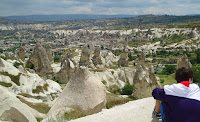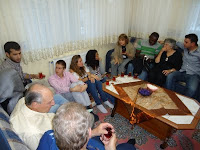 We arrived in Cappadocia yesterday, and were stunned by the surreal majesty of the landscape, which features geological formations that rival those anywhere. All the more fascinating is the fact that these conical formations have been carved out and used as homes, monestaries, castles, and forts for hundreds of years.
We arrived in Cappadocia yesterday, and were stunned by the surreal majesty of the landscape, which features geological formations that rival those anywhere. All the more fascinating is the fact that these conical formations have been carved out and used as homes, monestaries, castles, and forts for hundreds of years. For a complete photo album of Cappadocia, including the fascinating geography and the dinner at the Turkish home described below, click here.

Home visit facilitates invaluable people-to-people connections
CAPPADOCIA, TURKEY—I watched the students closely as they walked up the stairs and into the living room of a typical Turkish family. If I had to choose one word to describe their demeanors (and mine), I would say we were all apprehensive.
Two hours later, our demeanor would be more than slightly different.
The four students and I were at a Turkish home as part of People to People Peace Camp, which is bringing 28 young people from 23 countries together to experience peace. Several couples from a parallel adult program also joined us.
The idea of the in-home evening was to expose us to a typical Turkish residence and some home-cooked Turkish delicacies.
 As we sat down around a table in the living room, there was an awkward silence. I know the kids and I were thinking the same thing—what should we talk about? We were saved as the food began arriving. The delicious dinner broke the ice, and gave us all something to discuss, namely what it was and how it was prepared. I was proud of our Peace Camp kids, who cheerfully ate everything that was put in front of them. The dinner consisted of traditional salad, tasty really long grained rice garnished with yogurt, spectacularly delicious lentil soup, and an interesting pudding made with honey and tiny bits of chicken. I honestly enjoyed everything. The kids were wonderfully diplomatic and gracious, even though the odds were against them liking everything that was served.
As we sat down around a table in the living room, there was an awkward silence. I know the kids and I were thinking the same thing—what should we talk about? We were saved as the food began arriving. The delicious dinner broke the ice, and gave us all something to discuss, namely what it was and how it was prepared. I was proud of our Peace Camp kids, who cheerfully ate everything that was put in front of them. The dinner consisted of traditional salad, tasty really long grained rice garnished with yogurt, spectacularly delicious lentil soup, and an interesting pudding made with honey and tiny bits of chicken. I honestly enjoyed everything. The kids were wonderfully diplomatic and gracious, even though the odds were against them liking everything that was served.The conversation picked up during dinner, and reached overdrive as we sipped flavorful, strong tea in a sitting room. I talked politics and sports with our genial host Ismail, who moved about the room making it a point to spend at least a few minutes with each guest. Ismail’s nephew Ahmed, 12, also hung around, curious but shy. Finally, I called him over, and he walked sheepishly to the comfortable stuffed chair where I sat. I found out that Ahmed is learning English, so we practiced a few greetings. Then, Ahmed taught me some Turkish (table, for example, is masa).
 Our students educated their hosts about their home countries like Lithuania and Morocco, and we all shared a warm feeling when Ismail’s sister-in-law brought out colorful head scarves as gifts for the ladies in our party.
Our students educated their hosts about their home countries like Lithuania and Morocco, and we all shared a warm feeling when Ismail’s sister-in-law brought out colorful head scarves as gifts for the ladies in our party.As we left, I watched the students again closely. Their body language was much different than when they arrived, especially as they exchanged handshakes, hugs, email addresses, and cheek kisses with our hosts. Ahmed was pretty excited when I told him to email me his English assignments for feedback.
The idea behind People to People is that individuals can make connections that governments can’t or won’t, and that these connections can lay the foundation for peace. Anyone who doubts the viability of this idea wasn’t at dinner with us last night in Cappadocia, Turkey.
Great to see this in Turkey. Next time you are in Cappadocia, let us know. We would love to help anyway we can.
ReplyDeleteYou should connect with the International Guild of Visual Peacemakers (IGVP) at visualpeacemakers.org